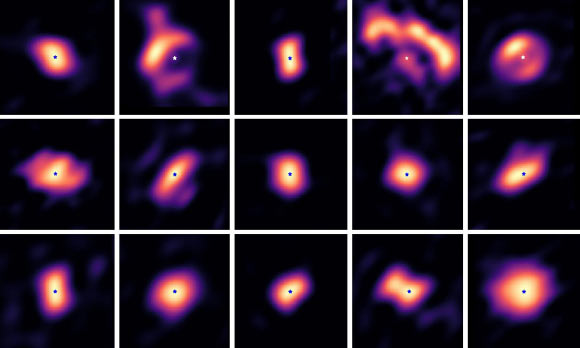Astronomers Observe Inner Rims of Protoplanetary Disks around Young Massive Stars | Astronomy – Sci-News.com
Astronomers using the PIONIER (Precision Integrated-Optics Near-infrared Imaging ExpeRiment) instrument on ESO’s Very Large Telescope Interferometer have photographed the inner rims — a key region for stellar and planet formation — of 15 planet-forming disks around young stars of spectral types A or B known as Herbig Ae/Be stars.

Kluska et al provided model-independent reconstructed images of 15 protoplanetary disks selected from the Herbig AeBe survey carried out with PIONIER at the Very Large Telescope Interferometer. Image credit: Kluska et al, doi: 10.1051/0004-6361/201833774.
“Protoplanetary disks are formed in unison with the star they surround,” said KU Leuven astronomer Jacques Kluska and colleagues.
“The dust grains in the disks can grow into larger bodies; this eventually leads to the formation of planets.”
“Rocky planets like the Earth are believed to form in the inner regions of protoplanetary disks, less than 5 AU from the star around which the disk has formed.”
“Before this new study, several pictures of these disks had been taken with the largest single-mirror telescopes, but these cannot capture their finest details.”
Dr. Kluska and co-authors captured the images of 15 protoplanetary disks around Herbig Ae/Be stars by using a technique called infrared interferometry.
This technique does not deliver an image of the observed source. The details of the disks needed to be recovered with a mathematical reconstruction technique. The technique is similar to how the first image of a black hole was captured.
“We had to remove the light of the star, as it hindered the level of detail we could see in the disks,” Dr. Kluska said.
“Distinguishing details at the scale of the orbits of rocky planets like Earth or Jupiter is equivalent to being able to see a human on the Moon, or to distinguish a hair at a 10 km distance,” said Dr. Jean-Philippe Berger, an astronomer at the Université Grenoble-Alpes.
“Infrared interferometry is becoming routinely used to uncover the tiniest details of astronomical objects. Combining this technique with advanced mathematics finally allows us to turn the results of these observations into images.”
“You can see that some spots are brighter or less bright, like in the images above; this hints at processes that can lead to planet formation,” the astronomers said.
“For example, there could be instabilities in the disk that can lead to vortices where the disk accumulates grains of space dust that can grow and evolve into a planet.”
The results were published in the journal Astronomy & Astrophysics.
_____
J. Kluska et al. 2020. A family portrait of disk inner rims around Herbig Ae/Be stars. Hunting for warps, rings, self shadowing, and misalignments in the inner astronomical units. A&A 636, A116; doi: 10.1051/0004-6361/201833774





